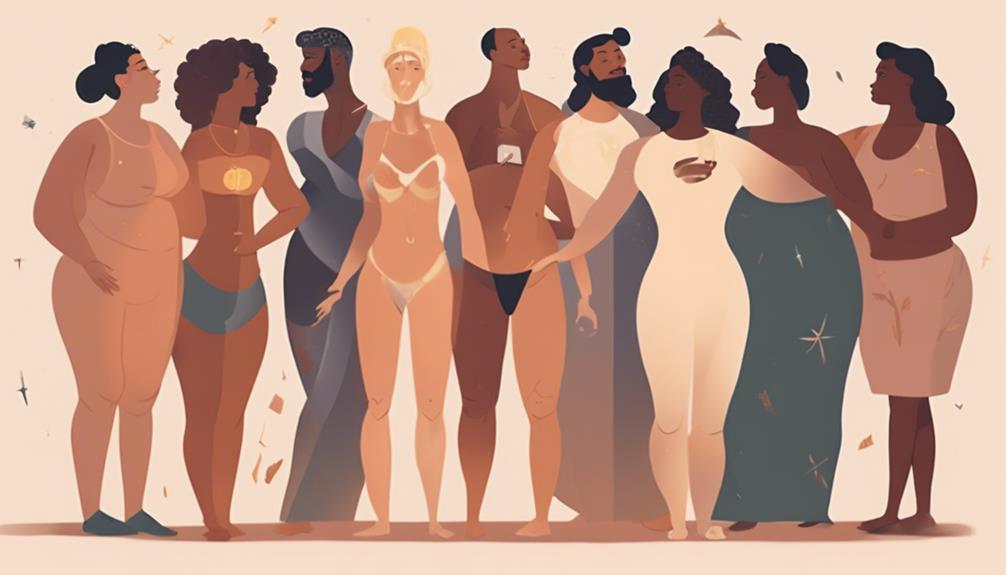Body Image in the Bible explores the delicate balance between physical beauty and spiritual values, inviting deeper reflection on self-worth.

Body Image in the Bible
Like a mirror reflecting a multifaceted image, the Bible presents complex views on body image that might surprise you. You'll find passages celebrating the human body as created in God's image, alongside warnings against vanity and calls for modesty.
The Apostle Paul, in particular, offers intriguing insights on how physical appearances intersect with spiritual values. But how does this ancient text influence our modern perceptions of beauty and worth?
As you explore these biblical perspectives, consider what they reveal about the enduring tension between the physical and spiritual, and how this tension shapes our understanding of self-worth and beauty.
Key Takeaways
- The Bible prioritizes inner beauty and spiritual worth over physical appearance.
- Scriptural teachings on modesty advocate for humility, challenging societal and gender norms.
- Biblical narratives use physical form and suffering to symbolize deeper spiritual lessons and transformation.
- The concept of imago Dei underscores the inherent dignity and value of every human body.
Creation in God's Image

In the Bible, the concept of humanity being created in God's image establishes a foundational understanding of body image that intertwines spiritual worth with physical form. This principle, known as imago Dei, carries profound implications for how you perceive yourself and others. It's not merely a matter of physical appearance; it's a declaration of inherent dignity and value in every person. The divine likeness debate centers on interpreting the extent of this resemblance. Is it physical, moral, spiritual, or a combination of these aspects?
The imago Dei implications extend beyond mere appearance, suggesting that your worth isn't contingent on physical standards. This perspective challenges societal norms and expectations about body image, offering a more inclusive and compassionate viewpoint. It's a reminder that your value isn't derived from how closely you align with contemporary beauty standards but from your intrinsic worth as a creation in the divine likeness.
Understanding this can lead to a healthier self-perception and interpersonal relationships. It encourages you to see beyond the superficial, recognizing the depth and breadth of what it means to be created in God's image.
Biblical Views on Physical Beauty

The Bible presents a nuanced perspective on physical beauty, emphasizing its transient nature while acknowledging its role in human experiences and divine narratives. This perspective invites you to consider how beauty is perceived and valued, beyond mere aesthetics.
Here are four key insights from biblical texts on physical beauty:
- Beauty's Fleeting Nature: Proverbs 31:30 warns that beauty is fleeting, suggesting that reliance on physical appearance is precarious. This aligns with the theme of vanity consequences, indicating that beauty's value is temporary and not the ultimate measure of worth.
- Inner Beauty's Precedence: 1 Peter 3:3-4 elevates the importance of inner beauty, such as a gentle and quiet spirit, over external adornments. This shift challenges cultural standards that prioritize physical beauty.
- Beauty in Divine Plans: Characters like Esther, whose beauty played a role in fulfilling God's purposes, show that physical attractiveness can be a part of divine narratives, yet it's not the sole factor of significance.
- Cultural Standards and Identity: The Song of Solomon celebrates physical beauty within a loving relationship, yet it also reflects on how beauty is interpreted against cultural standards, encouraging a broader understanding of beauty's role in identity.
These perspectives invite a reevaluation of how beauty is understood and valued, pointing towards a more holistic view that encompasses both physical and spiritual dimensions.
The Apostle Paul on Modesty

Delving into the teachings of the Apostle Paul, you'll find that modesty isn't merely about attire but encompasses a broader, more profound disposition towards humility and self-regulation. This notion of modesty, deeply embedded in Pauline epistles, transcends cultural interpretations and challenges prevailing gender roles of the time. Paul advocates for a modesty that goes beyond the superficial, urging believers to adopt an inward modesty that reflects in outward behavior, including dress.
Analyzing Paul's letters, it becomes evident that his emphasis on modesty is intricately linked with the early Christian community's desire to distinguish itself in a morally complex society. His teachings, therefore, must be interpreted within the socio-cultural context they were written in, acknowledging the dynamic interplay between cultural norms and the transformative Christian ethic.
Moreover, Paul's discourse on modesty subtly critiques and reshapes gender roles, suggesting a radical departure from the prevailing societal expectations. His approach encourages a reevaluation of personal conduct and societal norms, advocating for a community where modesty in thought and action is paramount, irrespective of gender. This stance not only challenged the status quo but also laid the groundwork for a more inclusive understanding of modesty and dignity within the Christian faith.
Suffering and the Body

While exploring the Apostle Paul's teachings on modesty, it's crucial to examine how scriptural narratives address suffering and its impact on the body, further enriching our understanding of Christian ethics. Biblical texts often depict suffering as a transformative experience, not just spiritually but also physically. This perspective offers a profound insight into the intersection of bodily experience and moral development.
Consider these four aspects:
- Leper Narratives: These stories aren't mere accounts of illness but serve as metaphors for social exclusion and the longing for restoration, both bodily and communal.
- Job's Afflictions: Job's physical suffering, depicted through sores and despair, is emblematic of a deeper, existential struggle, questioning the fairness of suffering and the integrity of faith in adversity.
- Physical Ailments as Metaphors: Often, physical suffering in the Bible symbolizes spiritual or moral ailments, urging a deeper introspection and a return to faithfulness.
- Empathy and Healing: The response to suffering, especially Jesus' healing miracles, underscores the value of empathy and restoration, highlighting the body's significance in spiritual and ethical life.
Understanding these narratives sheds light on the complex relationship between suffering, morality, and the human body in biblical ethics.
Resurrection and Transformation

In biblical discourse, resurrection narratives aren't merely historical accounts but serve as profound metaphors for transformation and renewal, both spiritually and physically. This metamorphosis symbolism illustrates a journey from death to life, mirroring the spiritual rebirth experienced by believers. You're invited to see beyond the physical resurrection to understand a deeper, symbolic layer where body image undergoes a divine transformation.
The resurrection stories, especially that of Jesus, aren't just about coming back to life; they're about a complete overhaul of what it means to exist in a body. This isn't merely about physical appearance; it's about the essence of being transformed in the light of divine truth. You undergo a spiritual metamorphosis, shedding the old self for a new, glorified existence. This process reflects the ultimate spiritual rebirth, where the physical body is reborn into a glorified form, free from the blemishes of sin and mortality.
Thus, in the biblical perspective, body image transcends mere physicality. You're called to view your body as a vessel for spiritual rebirth, destined for transformation and renewal in the image of the divine. This spiritual metamorphosis redefines body image, emphasizing its impermanence and the promise of a glorified transformation.
Frequently Asked Questions
How Does the Concept of Body Image in the Bible Align With Contemporary Issues of Body Positivity and Self-Acceptance?
You're diving into how contemporary issues of body positivity and self-acceptance align with the Bible's view on body image. By analyzing modern interpretations, you'll uncover that the divine perspective on bodies is largely positive, emphasizing inherent worth and beauty.
This contrasts with today's often narrow beauty standards. Understanding this alignment can deepen appreciation for one's body as a reflection of divine craftsmanship, encouraging a more inclusive and accepting approach to body image.
Are There Any Biblical Figures Who Struggled With Their Body Image, and What Lessons Can We Learn From Their Experiences?
You might be curious if any historical figures faced body image issues and what insights we can derive from their stories. Analyzing David's confidence and Leah's perception provides a rich, scholarly exploration.
David's unwavering self-assurance despite his physical stature and Leah's struggle with her own appearance offer profound lessons on self-acceptance.
Their experiences encourage us to view our bodies through a lens of acceptance and confidence, rather than criticism.
How Does the Bible Address the Issue of Body Shaming or Speaking Negatively About One's Own or Others' Physical Appearance?
You're exploring how negative talk about physical appearance is addressed, without focusing on body image. Analyzing this, the Bible indirectly tackles the issue through themes like Dietary Laws and the Creation Story.
These narratives emphasize respect for the body as a creation and maintaining it through healthy practices, suggesting a framework against body shaming. It's more about honoring what's been given than criticizing physical forms, guiding us towards a more respectful discourse on appearance.
In What Ways Does the Bible's Teaching on Body Image Differ Across Various Cultures and Historical Contexts Within Its Text?
You'll find that cultural interpretations and historical representations of body image shift significantly within the text you're exploring. These variations aren't just superficial; they reflect deep-seated values and norms of the time.
As you analyze these texts, consider how societal standards of beauty and acceptability have evolved. This analysis will reveal not only the diversity of thought but also the underlying constants in the perception of physical form across different epochs.
How Can Christians Reconcile the Pursuit of Physical Fitness and Beauty With the Biblical Emphasis on Spiritual Virtues and Inner Beauty?
To reconcile physical fitness and beauty pursuits with spiritual virtues, you'll find balance is key. Acknowledge the Bible's dietary laws and exercise ethics as guiding principles. Analyze how these teachings encourage maintaining your body as a temple, while emphasizing spiritual growth and inner beauty.
Understand that moderation and intentionality in physical care reflect respect for oneself and God's creation, aligning physical practices with spiritual well-being and moral integrity.
Conclusion
In examining biblical texts, it's evident that body image is intricately linked to spiritual and moral values. Created in God's image, physical form holds divine significance, yet Scripture cautions against overvaluing external beauty.
Paul's emphasis on modesty underscores the virtue of focusing on inner qualities. Suffering and bodily transformation further illustrate the transient nature of our physical selves, pointing toward a resurrection where the body is transformed.
Thus, the biblical narrative offers a complex, nuanced perspective on body image, emphasizing spiritual over physical attributes.



Sign up